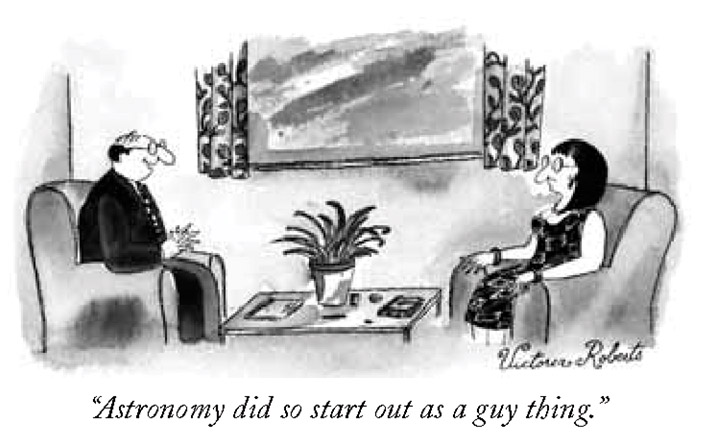
A Woman's Place is in the Dome
"Computers" and Stellar Classification
Women had an important role in astronomy early in the 20th century, but their treatment left a bit to be desired. A pioneer from the previous century, Maria Mitchell, observed: "Women's power of minute observation [is so suited to the natural sciences] that it seems strange that the hammer of the geologist is not seen in her hand or the tin box of the botanist." -- but few men agreed! (cartoon by Victoria Roberts, the New Yorker, 5/22/1995)
Pickering, director of Harvard College Observatory, recognized the pool of untapped talent in women, who were starting to get good educations (in the best families), but had no chances to use what they had learned later. His hiring of women was expanded by his successor, Harlow Shapley. Although the women were given jobs appropriate to professional astronomers (if they were skilled enough), in general they were treated as skilled labor rather than independent scientists. The first woman to actually get an astronomy Ph.D. from Harvard was Cecilia Payne, in the 1920s. Harvard had flatly denied her admission to graduate studies in physics, but Shapley circumvented the rules by establishing a Ph.D. program in astronomy and admitting her there. She was in fact the first Harvard astronomy Ph.D., as a result. Payne discovered that the pattern of spectra set up by Cannon reflected a progression of temperatures, and that stars were made mostly of hydrogen with some helium and less than 2% being all the other elements (which astronomers lump together as "metals").
Although Shapley had created an island where women worked productively, it was a tiny island indeed. For example, Harvard would not permit him to hire women as full staff members of the observatory, and for a time he paid Payne out of his gardening budget. Institutional recognition of Payne's contributions in the form of promotion to a professorship was delayed until 1956. In a pessimistic moment, she once said women pursuing careers in astronomy "should do so only if nothing else will satisfy them --- for nothing else is probably what they will get." Her experiences and often frustrating struggle for recognition are described in her autobiography (recommended reading).
Shortly afterwards, Shapley accepted other women as Ph.D. students, including Professor George Rieke's mother (who earned a Ph.D. four years after Payne). She recalled a letter answering her advisor's inquiry about studying at Princeton:
"Dear Fox,
You asked what opportunity there is for a woman at Princeton Observatory.
There is N*O*N*E.
Yours,
Duggin
Needless to say, she applied to Harvard and not Princeton!